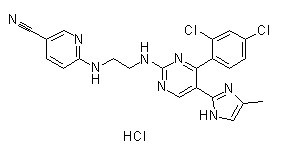All AbMole products are for research use only, cannot be used for human consumption.

CHIR-99021 HCl (Laduviglusib; CT99021) exhibits >500-fold selectivity for GSK-3 over closely related kinases. CHIR-99021 also displays >800-fold selectivity against 45 additional enzymes and receptors. CHIR-99021 (3 μM) increases free cytosolic β-catenin by 1.9-fold, mimicking the canonical Wnt signaling pathway in 3T3-L1 preadipocytes. CHIR-99021 promotes primary beta cell replication in isolated rat islets at concentrations as low as 1 μM, with 2-3 fold increase of cell replication at 5 μM of CHIR-99021 treatment. Oral administration of CHIR-99021 at 16 or 48 mg/kg 1 hour before oral glucose challenges in ZDF rats significantly improves glucose tolerance with 14% and 33% reduction in plasma glucose at 16 mg/kg and 48 mg/kg, respectively, and the higher dose of CHIR-99021 also reduces hyperglycemia before the oral glucose challenge.

Cell. 2024 Dec 26;187(26):7374-7393.e28.
Decoding transcriptional identity in developing human sensory neurons and organoid modeling
CHIR-99021 HCl purchased from AbMole

Nature. 2022 Jul;607(7917):149-155.
Deciphering the immunopeptidome in vivo reveals new tumour antigens
CHIR-99021 HCl purchased from AbMole

Nat Commun. 2022 Oct 20;13(1):6230.
Acute deletion of TET enzymes results in aneuploidy in mouse embryonic stem cells through decreased expression of Khdc3
CHIR-99021 HCl purchased from AbMole

Mol Biol Cell. 2022 Jul 1;33(8):mbcP22031008.
Deciphering the tumor-specific immunopeptidome in vivo with genetically engineered mouse models
CHIR-99021 HCl purchased from AbMole

2020 Sep.
Developing a model to assess the contribution of cytokeratin 19-expressing cells during multipotent stromal cell-induced islet regeneration
CHIR-99021 HCl purchased from AbMole
| Cell Experiment | |
|---|---|
| Cell lines | CHO-IR cells |
| Preparation method | GS activity assays. CHO-IR cells expressing human insulin receptor, (provided by Hans Bos) were grown to 80% confluence in Hamm’s F12 medium with 10% fetal bovine serum and without hypoxanthine (34). Trypsinized cells were seeded in 6-well plates at 1 × 106 cells/well in 2 ml of medium without fetal bovine serum. After 24 h, medium was replaced with 1 ml of serum-free medium containing GSK-3 inhibitor or control (final DMSO concentration <0.1%) for 30 min at 37°C. Cells were lysed by freeze/thaw in 50 mmol/l tris (pH 7.8) containing 1 mmol/l EDTA, 1 mmol/l DTT, 100 mmol/l NaF, 1 mmol/l phenylmethylsulfonyl fluoride, and 25 μg/ml leupeptin (buffer A) and centrifuged 15 min at 4°C/14000g. The activity ratio of GS was calculated as the GS activity in the absence of glucose-6-phosphate divided by the activity in the presence of 5 mmol/l glucose-6-phosphate, using the filter paper assay of Thomas et al. |
| Concentrations | 0~500nM |
| Incubation time | 30min |
| Animal Experiment | |
|---|---|
| Animal models | fasting ZDF rats |
| Formulation | 20 mmol/l citrate-buffered 15% Captisol or suspensions in 0.5% carboxymethylcellulose |
| Dosages | 30 mg/kg |
| Administration | oral gavage |
| Molecular Weight | 501.8 |
| Formula | C22H18Cl2N8.HCl |
| CAS Number | 1797989-42-4 |
| Solubility (25°C) | DMSO 35 mg/mL Water 6 mg/mL |
| Storage |
Powder -20°C 3 years ; 4°C 2 years In solvent -80°C 6 months ; -20°C 1 month |
| Related GSK-3 Products |
|---|
| Phospho-Glycogen Synthase Peptide-2(substrate)
Phospho-Glycogen Synthase Peptide-2 (substrate) is peptide substrate for glycogen synthase kinase-3 (GSK-3) and can be used for affinity purification of protein-serine kinases. |
| FRATtide
FRATtide is a peptide derived from the GSK-3 binding protein that inhibits the phosphorylation of Axin and β-catenin. |
| ZDWX-25
ZDWX-25 is a highly potent GSK-3β and DYRK1A dual inhibitor with an IC50 value of 71 nM for GSK-3β. |
| TC-G 24
TC-G 24 is a potent, selective glycogen synthase kinase-3β (GSK-3β) inhibitor with an IC50 of 17.1 nM. |
| SAR502250
SAR502250 is a potent, selective, ATP competitive, orally active and brain-penetrant inhibitor of GSK3, with an IC50 of 12 nM for human GSK-3β. |
All AbMole products are for research use only, cannot be used for human consumption or veterinary use. We do not provide products or services to individuals. Please comply with the intended use and do not use AbMole products for any other purpose.


Products are for research use only. Not for human use. We do not sell to patients.
© Copyright 2010-2024 AbMole BioScience. All Rights Reserved.
